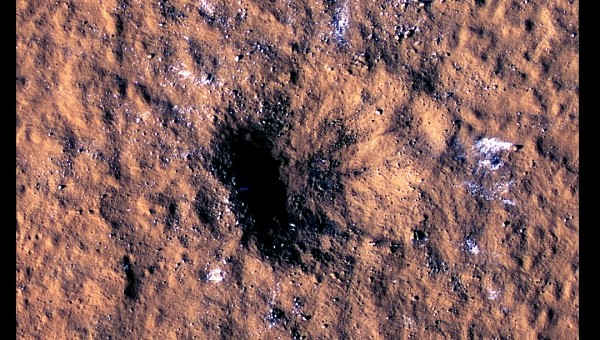NASA's dust-chocked InSight lander worked together with the agency's Mars Reconnaissance Orbiter (MRO) to make a scientific discovery. Data collected from the two missions revealed that a meteoroid struck the Red Planet's surface last year. NASA says that this is believed "to be one of the largest craters ever witnessed forming any place in the solar system."
Last year, right before Christmas, NASA's InSight lander felt the Martian ground shake. Although the spacecraft has detected so far 1,318 marsquakes since it first arrived on the planet in 2018, the one recorded on December 24th was the first to have surface waves.
That marsquake had a magnitude of 4, and at that time, scientists didn't know what caused it. Now, together with the data provided by MRO, they were able to track down the source: a meteoroid impact generated waves that traveled along the planet's surface.
Scientists used MRO's Mars Color Imager (MARCI) instrument to pinpoint the impact's blast zone and determine when it occurred. This evidence was correlated with the seismic epicenter, concluding that the powerful marsquake was caused by a meteoroid strike.
The orbiter's High-Resolution Imaging Science Experiment (HiRISE) color camera also observed chunks of ice excavated by the meteoroid. What's interesting is that the buried ice has never been seen this close to the Martian equator. This is a major finding that will have an impact on NASA's future Mars missions. Astronauts that will arrive on the Red Planet could use subsurface ice for a number of purposes, including drinking water and rocket fuel.
The size of the meteoroid that hit the planet is estimated to be somewhere between 16 and 39 feet (5 to 12 meters). For Earth, this alien rock wouldn't have caused any problems since it would have burned in the atmosphere. However, in Mars' thin atmosphere, the impact was significant. The crater left behind is about 492 feet (150 meters) wide and 70 feet (21 meters) deep.
According to NASA, it is thought to be one of the largest craters that have been recently formed on the Red Planet. There are other massive craters on Mars, but they are far older, and they were formed before any spacecraft explored the planet.
That marsquake had a magnitude of 4, and at that time, scientists didn't know what caused it. Now, together with the data provided by MRO, they were able to track down the source: a meteoroid impact generated waves that traveled along the planet's surface.
Scientists used MRO's Mars Color Imager (MARCI) instrument to pinpoint the impact's blast zone and determine when it occurred. This evidence was correlated with the seismic epicenter, concluding that the powerful marsquake was caused by a meteoroid strike.
The orbiter's High-Resolution Imaging Science Experiment (HiRISE) color camera also observed chunks of ice excavated by the meteoroid. What's interesting is that the buried ice has never been seen this close to the Martian equator. This is a major finding that will have an impact on NASA's future Mars missions. Astronauts that will arrive on the Red Planet could use subsurface ice for a number of purposes, including drinking water and rocket fuel.
The size of the meteoroid that hit the planet is estimated to be somewhere between 16 and 39 feet (5 to 12 meters). For Earth, this alien rock wouldn't have caused any problems since it would have burned in the atmosphere. However, in Mars' thin atmosphere, the impact was significant. The crater left behind is about 492 feet (150 meters) wide and 70 feet (21 meters) deep.
According to NASA, it is thought to be one of the largest craters that have been recently formed on the Red Planet. There are other massive craters on Mars, but they are far older, and they were formed before any spacecraft explored the planet.







